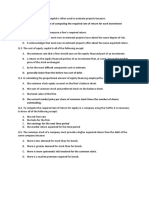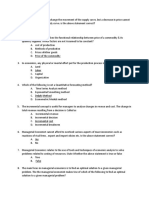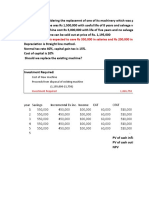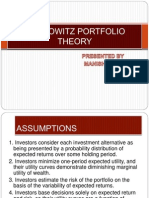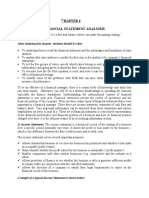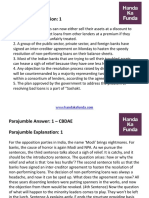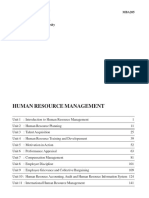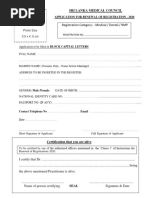0 ratings0% found this document useful (0 votes)
446 viewsNPTEL Course Financial Management Assignment I
This document contains a 12 question assignment on the topic of financial management. The questions cover key concepts such as the goals of financial management being maximizing firm value and shareholder wealth, the three broad areas of financial decisions being capital budgeting, working capital management, and capital structure, and wealth maximization taking into account the risk, timing, and expected returns of anticipated cash flows. The answer key is provided at the end.
Uploaded by
yogeshgharpureCopyright
© © All Rights Reserved
Available Formats
Download as PDF, TXT or read online on Scribd
0 ratings0% found this document useful (0 votes)
446 viewsNPTEL Course Financial Management Assignment I
This document contains a 12 question assignment on the topic of financial management. The questions cover key concepts such as the goals of financial management being maximizing firm value and shareholder wealth, the three broad areas of financial decisions being capital budgeting, working capital management, and capital structure, and wealth maximization taking into account the risk, timing, and expected returns of anticipated cash flows. The answer key is provided at the end.
Uploaded by
yogeshgharpureCopyright
© © All Rights Reserved
Available Formats
Download as PDF, TXT or read online on Scribd
You are on page 1/ 2
NPTEL Course
Financial Management
Assignment I
1. The concept of financial management is mainly concerned with:
a. Arrangement of funds
b. Efficient management of every business
c. All aspects of acquiring and utilizing financial resources for firms’ activities
d. None of the above
2. Term structure of interest rates depicts the relationship between:
a. Between the rates of interest on all securities
b. Between the interest rate on a security and its time to maturity
c. Between the yield on a bond and its default rate.
d. Between the yield on a bond and market interest rate.
3. What are the three broad areas of financial decisions in an organization?
a. Capital budgeting, working capital management and capital structure
b. Capital budgeting, working capital management and dividend decisions
c. Working capital management, capital structure and dividend decisions
d. None of the above
4. The long-term goal of financial management is to:
a. Distribute the maximum dividends to the shareholders
b. maximizing the earnings per share
c. maximizing the profit of the firm
d. maximizing the value of the firm's common stock
5. The role of financial manager has become challenging due to:
a. LPG policy implemented after 1990s
b. Traditional business practices
c. Simple accounting procedures
d. Manual maintenance of records
6. The market price of a share of common stock is determined by:
a. the respective companies
b. the government
c. shareholders
d. the investment markets
7. The decision area of working capital management is concerned with:
a. revenue expenses of the firm
b. long term assets and liabilities
c. short term assets and liabilities
d. All of the above
8. Wealth of the shareholders or firm's value is represented by:
a. the number of shareholders a firm has
b. the book value of the firm's assets less the book value of its liabilities
c. the market price per share of the firm's common stock.
d. the amount of salary paid to its employees
9. As per the norms, the debt-equity ratio of a firm should be:
a. 2:1
b. 1:2
c. 1.5:1
d. 3:1
10. Wealth maximization is considered as the most feasible goal of financial management
as it takes into account:
a. Amounts of returns expected
b. Timing of anticipated returns
c. Risk associated with uncertainty of returns
d. All of the above
11. A(n) _______ would be an example of an agent, whereas a(n) would be an example
of a principal
a. manager; owner
b. manager; shareholder
c. bondholder; accountant
d. bondholder; shareholder
12. Types of capital budgeting decision does not include:
a. Diversification
b. Procurement of funds
c. Replacement
d. Expansion
ANSWER KEY
1(c) 2(b) 3(a) 4(d) 5(a) 6(d)
7(c) 8(c) 9(a) 10(d) 11(b) 12(b)
You might also like
- Nptel Course Financial Management Assignment Ii: Liabilities Rs. (Million) Asset Rs. (Million)No ratings yetNptel Course Financial Management Assignment Ii: Liabilities Rs. (Million) Asset Rs. (Million)3 pages
- Chapter 7 - Analyzing Consumer Markets and Buyer Behavior Multiple Choice QuestionsNo ratings yetChapter 7 - Analyzing Consumer Markets and Buyer Behavior Multiple Choice Questions21 pages
- MBA Supplementary Resources Finance GlossaryNo ratings yetMBA Supplementary Resources Finance Glossary21 pages
- Multiple Choice Questions: Financial ManagementNo ratings yetMultiple Choice Questions: Financial Management2 pages
- Financial Management Assignment Answers by Kailash - WatermarkNo ratings yetFinancial Management Assignment Answers by Kailash - Watermark6 pages
- Nptel Course Financial Management Assignment ViNo ratings yetNptel Course Financial Management Assignment Vi3 pages
- NPTEL Course Financial Management Assignment IVNo ratings yetNPTEL Course Financial Management Assignment IV2 pages
- NPTEL Course Global Marketing Management Assignment IIINo ratings yetNPTEL Course Global Marketing Management Assignment III3 pages
- Corporate Social Responsibility - Unit 10 - Week 8No ratings yetCorporate Social Responsibility - Unit 10 - Week 82 pages
- NPTEL Course Global Marketing Management Assignment INo ratings yetNPTEL Course Global Marketing Management Assignment I3 pages
- NPTEL Course Financial Management Assignment VNo ratings yetNPTEL Course Financial Management Assignment V2 pages
- What Kind of Numericals Are Asked in Finance Paper (Phase-2) of RBI Grade B Exam - QuoraNo ratings yetWhat Kind of Numericals Are Asked in Finance Paper (Phase-2) of RBI Grade B Exam - Quora12 pages
- Derivative and Risk Management MCQ: Multiple ChoiceNo ratings yetDerivative and Risk Management MCQ: Multiple Choice18 pages
- Management of Commercial Banking Assignment-Week 2No ratings yetManagement of Commercial Banking Assignment-Week 215 pages
- Multiple Choice Questions 1 The Random Walk Theory Suggests ANo ratings yetMultiple Choice Questions 1 The Random Walk Theory Suggests A2 pages
- Financial Derivatives - MCQ by Sam DrewNo ratings yetFinancial Derivatives - MCQ by Sam Drew13 pages
- Security Analysis & Portfolio MGT Practice QuestionsNo ratings yetSecurity Analysis & Portfolio MGT Practice Questions29 pages
- FCI AG III 2023 Previous Year Paper - Paid - UpdatedNo ratings yetFCI AG III 2023 Previous Year Paper - Paid - Updated206 pages
- 100 Sample Questions of MCQ Project Management100% (1)100 Sample Questions of MCQ Project Management10 pages
- Lesson 1: Week 2 (Chapter 14) : DX Adt+bdzNo ratings yetLesson 1: Week 2 (Chapter 14) : DX Adt+bdz17 pages
- Marketing Management SAMPLE PAPER SolutionNo ratings yetMarketing Management SAMPLE PAPER Solution22 pages
- Productions and Opearations BNU V SEM BBA NEP L NEW 1No ratings yetProductions and Opearations BNU V SEM BBA NEP L NEW 120 pages
- Financial-Management Solved MCQs (Set-12)No ratings yetFinancial-Management Solved MCQs (Set-12)8 pages
- KEA Assistant Professor March 2022 (Commerce) EnglishNo ratings yetKEA Assistant Professor March 2022 (Commerce) English21 pages
- Strategic Financial Management: School of Distance EducationNo ratings yetStrategic Financial Management: School of Distance Education2 pages
- Himalayan Camp Manali Activity Based CampNo ratings yetHimalayan Camp Manali Activity Based Camp2 pages
- Master of Business Administration (M.B.A.) Semester-I (C.B.C.S.) Examination Principles of Management Compulsory Paper-1No ratings yetMaster of Business Administration (M.B.A.) Semester-I (C.B.C.S.) Examination Principles of Management Compulsory Paper-11 page
- Hidden Syllabus of Public Administration For CSE - Lohit Matani - Lohit MataniNo ratings yetHidden Syllabus of Public Administration For CSE - Lohit Matani - Lohit Matani4 pages
- How To Tell Wild Animals by Carolyn WellsNo ratings yetHow To Tell Wild Animals by Carolyn Wells7 pages
- Active TP Summary Website Clean March 3 2017No ratings yetActive TP Summary Website Clean March 3 20175 pages
- Sri Lanka Medical Council: Coloured Photograph Photo Size 3.5 X 4. 5 CMNo ratings yetSri Lanka Medical Council: Coloured Photograph Photo Size 3.5 X 4. 5 CM3 pages
- The Mahavadanasutra A New Edition Based On Manuscripts Discovered in Northern Turkestan Sanskrit Worterbuch Beihefte Takamichi Fukita100% (2)The Mahavadanasutra A New Edition Based On Manuscripts Discovered in Northern Turkestan Sanskrit Worterbuch Beihefte Takamichi Fukita64 pages
- Air Ticket Booking - Book Flight Tickets - Cheap Air Fare - LTC Fare - IRCTC AIR0% (1)Air Ticket Booking - Book Flight Tickets - Cheap Air Fare - LTC Fare - IRCTC AIR1 page
- R24AMR_Temenos_Digital_ReleaseHighlightsNo ratings yetR24AMR_Temenos_Digital_ReleaseHighlights41 pages
- 004 - Fiduciarie State For Morocco ForbesNo ratings yet004 - Fiduciarie State For Morocco Forbes5 pages
- The War Is Forcing Russia's Balkan Friends To Recalibrate - The EconomistNo ratings yetThe War Is Forcing Russia's Balkan Friends To Recalibrate - The Economist2 pages
- Ethical Decision Making For The 21st Century Counselor 1st Edition Sheperis Test Bank100% (1)Ethical Decision Making For The 21st Century Counselor 1st Edition Sheperis Test Bank42 pages
- The Casualties in The Caraga Region. (2 PTS)No ratings yetThe Casualties in The Caraga Region. (2 PTS)2 pages
- Edelweiss Passive Equity Deck - Edelweiss MFNo ratings yetEdelweiss Passive Equity Deck - Edelweiss MF75 pages
- IIA IIA-CIA-Part1 Free Practice Exam & Test TrainingNo ratings yetIIA IIA-CIA-Part1 Free Practice Exam & Test Training2 pages








